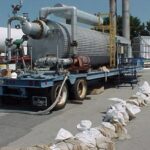No data found for Custom Course Number
No data found for Custom Course Units
Intended Audience: hydrologists, civil engineers, hydraulic engineers, highway engineers and environmental engineers
PDH UNITS: 4
The Manning equation is a widely used empirical equation for uniform open channel flow of water. It provides a relationship among several open channel flow parameters of interest: flow rate or average velocity, bottom slope of the channel, cross-sectional area of flow, wetted perimeter, and Manning roughness coefficient for the channel. Open channel flow takes place in natural channels like rivers and streams, as well as in manmade channels like those used to transport wastewater and in circular sewers flowing partially full. The main topic of this course is uniform open channel flow, in which the channel slope, water velocity and water depth remain constant. This includes calculations with the Manning equation and the use of Excel spreadsheets for those calculations. This course is intended for hydrologists, civil engineers, hydraulic engineers, highway engineers and environmental engineers. After completing this course you will have knowledge about the basic nature of flow in open channels and the common ways of classifying open channel flow (laminar or turbulent, steady state or unsteady state, uniform or non-uniform, and critical, subcritical or supercritical). Practice in the use of the Manning equation for a variety of uniform open channel flow calculations will be gained through several worked examples.
Learning Objectives
- Distinguish the differences between laminar & turbulent, steady state & unsteady state, and uniform & non-uniform open channel flow.
- Calculate the hydraulic radius for flow of a specified depth in an open channel with specified cross-sectional shape and size.
- Compute the Reynolds Number for a specified open channel flow and determine whether the flow will be laminar or turbulent flow.
- Use tables such as the examples given in this course to determine a value for Manning roughness coefficient for flow in a manmade or natural open channel.
- Apply the Manning Equation to calculate volumetric flow rate, average velocity, Manning roughness coefficient, or channel bottom slope, if given adequate information about a reach of open channel flow.
- Apply the Manning Equation, with an iterative procedure, to calculate normal depth for specified volumetric flow rate, channel bottom slope, channel shape & size, and Manning roughness coefficient for a reach of open channel flow.
- Determine Manning Equation calculations in either U.S. units or S.I. units, as well as the Manning roughness coefficient for a natural channel based on descriptive information about the channel.
- Establish a variety of calculations for full or partially full flow under gravity in a circular pipe.
Course Reviews
5
- 5 stars1
- 4 stars0
- 3 stars0
- 2 stars0
- 1 stars0
Once completed, your order and certificate of completion will be available in your profile when you’re logged in to the site.
Ethics Courses

E – 1814 World Trade Center- Engineering Ethical Issues in the Design, Construction, and the Investigation of Its Collapseby Dr. Abolhassan Astaneh-Asl, Professor Emeritus. Ph.D., PE

E – 1865 Engineering Ethics: The Cases of Challenger and Columbia Shuttle Disasters; “Hold Safety Paramount” to Prevent Loss of Lifeby Dr. Abolhassan Astaneh-Asl, Professor Emeritus. Ph.D., PE











The course was in depth and relevant to my work. The problems were challenging but fair. I would like to have had a downloadable excel sheet, but it was fairly easy to create my own.